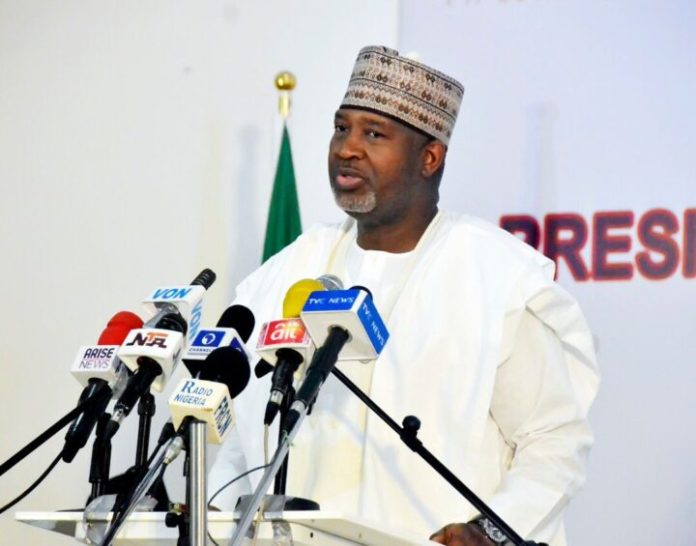The Federal Executive Council (FEC) has approved the sum of N2.29 billion for the assembly of Hungarian Magnus light aircraft at the Nigerian College of Aviation Technology (NCAT), Zaria, Kaduna State.
The council gave the approval Wednesday at a meeting chaired by Vice President Yemi Osinbajo in Abuja.
Speaking after the meeting, Hadi Sirika, the aviation minister, explained that the renewed demand for “gyro recovery aircraft” required the production of light aircraft that he said were durable for training military and civilian pilots.
Sirika said the first set of the assembled plane is expected to fly within the last four months of Muhammadu Buhari’s administration.
He revealed that his ministry submitted two memorandums related to the local assembly of the Magnus aircraft and a review of the cost of the Instrument Landing System (ILS) at three airports for an additional N546.1 billion.
“We had two memos in the council. The first is the procurement and assembly of the Magnus Centennial aircraft and stimulator in Zaria,” Sirika said.
“So, I am happy to announce that today is reality. In fact, we will assemble the Magnus plane and continue to do so and [in] In the not too distant future by the grace of God, the civil aviation industry will start manufacturing right here in the country. But [we’re] starting with assembling these training planes.
“So, the memos have been approved in council. The aircraft manufacturer is based in Hungary and has a local company called Ingenious to make it in Zaria. And the total amount of the contract is N2,296,897,404 with an execution period of 18 months”.
A TRAINING PLANE
The minister explained that the Magnus plane is a ‘rotary plane’.
According to Sirika, the world of civil aviation stopped its training program [on] Spinning and Spin Recovery – A must-have navigational skill for pilots.
He said that ‘spin’ literally means “to spin something at an unusual height that our club goes through” and therefore students are taught to identify when they are in a spinning situation and how to recover from the situation sooner. of it becoming a disaster.
The minister, who said many pilots were trained in the skill, added that the need to spin and regain spin eventually faded as planes became more technologically advanced and sophisticated.
“But then again, everyone realizes that we still spin or need to develop this skill to recover from a spin situation,” Sirika said.
“So most manufacturers stopped producing trainers for that purpose. And so, there aren’t many people now who manufacture.
“The company at Messrs Maganus, realized that gap [and] He began to produce planes that can turn in and out of it, so that students can be trained in that. And because of our utmost attention to safety, we think this should go back to training in Nigeria, even in the United States of America, who, at some point stopped, are now going back to training students in this spin recovery and turns.
“So this plane is completely aerobic, it is dedicated to aerobatics. And I think the Nigerian air force and the air force throughout the region will be interested and excited about this development, we are taking the lead in civil aviation. It is our intention to produce them here, assemble them here, [possibly] in the future, sell them to wherever we are interested in around the world.
“I think the first assembly of one or two aircraft will take place here in Nigeria and we will fly them within the remaining four months that we have as a government. Therefore, it is another item that is marked on our plate and for which we remain grateful to President Muhammadu Buhari and his government.”
FEC INCREASES ILS PROCUREMENT FUND BY N546 MILLION
The minister also revealed that the FEC also approved the memorandum that revised the estimated total cost and the increase, the contract for the acquisition and installation of the Instrument Landing System (ILS) at three airports, namely: Port Harcourt International Airport , Kano International Airport and Katsina Airport.
He said the contract, which was awarded earlier, had to be reviewed due to FX fluctuations.
“And of course, the time it took and the cost of the items increased tremendously. That is why we are back in council, revising it with an additional N546,109,336.33 with 7.5 per cent VAT and an additional nine-month completion period for this airport,” he said.
“As we say in aviation, most of the things we do, passengers don’t see. Passengers are concerned about the air conditioning system, the conveyor belt, and the restrooms at our facility.
“However, this particular ILS team tells you to fire an approach to an airport, zero visibility ground; if it has a category 3C landing system. And we’re having them all over the country. They will be at most airports in Nigeria.
“The government is making efforts to put all the airports, but then the airlines will have to put them on their team, interpret ours on their own plane and also train their pilots to fly this facility that has been provided.
“All these are security issues, which is our main concern in civil aviation under the presidency of Muhammadu Buhari.”
N546.11 MILLION FOR CATEGORY 3C LANDING SYSTEMS
Meanwhile, Sirika also revealed that the council approved N546.11 million for the procurement and installation of the ‘3C’ category landing system at 15 airports across the country.
However, the installation will start from the Port Harcourt International Airport, Omagwa; Mallam Aminu Kano International Airport, Kano; and Katsina airport.
The category 3C landing system, he explained, allows pilots to land in zero visibility conditions.







